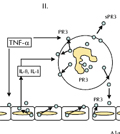The eLitMed.hu medical portal uses computer cookies for convenient operation. Detailed information can be found in the Cookie-policy.
Lege Artis Medicinae - 2005;15(02)
Content
[ALDOSTERONE AT THE BEGINNING OF THE 21ST CENTURY]
[The discovery of aldosterone as the principal mineralocorticoid hormone led to a new era in the study of the regulation and the pathological/clinical relevance of the fluid-salt homeostasis and blood pressure. Here, we discuss briefly the history of the discovery of aldosterone, its biosynthesis, the mechanism of action, regulation and the diseases which are associated with its pathologically increased production and hypertension: primary and secondary hyperaldosteronisms. Considering their clinical significance, we focus on primary hyperaldosteronisms as they represent a considerable portion of secondary hypertensions that can be definitively cured. Differential diagnosis issues related to other forms of hypertension of different origins are discussed in detail. Recent findings of the past fifteen years indicate that besides its classical genomical actions aldosterone has much more diverse non-genomic actions as well including proinflammatory and profibrotic effects even in physiological concentrations. Based on these observations, aldosterone can be regarded as a risk hormone in the aetiology of cardiomyopathies, vasculopathies and neuropathies and therapeutical consequences are also discussed.]
[LONG-TERM OXYGEN TREATMENT]
[Long-term oxygen therapy is the only treatment that has been shown to significantly improve life expectancy in patients with severe chronic obstructive pulmonary disease (COPD) exhibiting marked hypoxemia. There has been sginificant advances in the longterm oxygen therapy in the last two decades caused by the technological improvements in oxygen delivery systems as well as our better knowledge of the beneficial effects of the longterm oxygen therapy including better quality of life, exercise tolerance and pulmonary hemodynamic effects. This expansive therapy requires the documentation of chronic arterial hypoxemia by arterial blood gas analysis or pulsoximetry which should be reassesed during chronic care of these patients. Besides hypoxaemia, the consequences of tissue hypoxia induced by different problems in the oxygenation chain should also be considered. Indication of long-term oxygen therapy is optimally based on evidence and pathophysiology, thereby the undesirable placebo effect or psychological addiction to oxygen can be reduced. Late laboratory diagnostics and poor patient compliance are the main determinants of undertreatment. The real value of the long-term oxygen therapy in indications other than hypoxaemic COPD requires more controlled studies.]
[THE IMMUNPATHOGENESIS OF VASCULITIDES]
[The vasculitides are clinicopathologic entities characterized by the inflammation and damage to blood vessels. Most vasculitic syndromes are mediated by immunopathogenic mechanisms. Most immune vasculitides are idiopathic (“primary vasculitis”) and systemic. The “immune vasculitides” are classified according to their hypersensitivity reaction types: allergic angiitis, antineutrophil cytoplasmic antibody (ANCA) -associated vasculitis, immunecomplex vasculitis, and vasculitis associated with T cell-mediated hypersensitivity. Immunological features: eosinophilia plus elevated IgE are characteristic of allergic angiitis and granulomatosis (Churg-Strauss syndrome). No immune deposits can be found in situ in ANCA associated vasculitis (“pauci-immune vasculitis”). Immune complex deposits, by contrast, are the hallmark of immune-complex vasculitis, which is frequently associated with low complement levels. Inflammatory infiltration induced by Th1 cells distinguishes vasculitis associated with T cell-mediated hypersensitivity (granulomatous arteritis). This article is dealing with the immunological mechanisms which may play a central role in the development of vasculitides.]
[THE TREATMENT OF ACUTE ISCHEMIC STROKE BASED ON CURRENT GUIDELINES]
[Cerebrovascular diseases are third among the most frequent causes of mortality in developed countries and represent the most common cause of disability in adulthood. 80% of all acute stroke cases are of ischemic origin. The proven significant efficacy of intravenous thrombolysis with rt-PA in the NINDS rt-PA Stroke Trial was the cornerstone of the treatment of acute ischemic stroke, followed by several recommendations. From this time on, the attention shifted to early and appropriate recognition of symptoms and to organizing a quickly reacting emergency medical system in order to maximize the number of those patients transported immediately to the nearest stroke center to have the opportunity to be treated within three hours after their symptom onset. Specialized stroke facilities have documented benefit over other forms of stroke management concerning survival rates, but they need coordinated continuous multidisciplinary care for the patients, availability of CT scanner, laboratory examinations including tests of hemostasis, intensive care unit and well-trained stroke neurologists on 24-hours-a-day basis. Thrombolysis in these stroke centers with intravenous 0,9 mg/kg rt-PA improves the outcome of acute stroke with 30%. Although new guidelines strongly recommend the thrombolysis of selected ischemic stroke patients, the only evidence-based treatment of this condition has not yet become a part of the routine stroke management in Hungary. Regarding other specific antithrombotic therapeutic approaches, anticoagulation has the most contradictory status: in spite of well-defined theoretic considerations there are no evidence-based data in favour of routine anticoagulation in acute ischemic stroke, neither with heparin nor with low molecular weight heparins or heparinoids, while aspirin given within 24-48 hours after stroke onset was shown to have a significant but modest benefit. No data support the treatment with hemodilution or the administration of neuroprotective drugs. Evidence accumulating continuously determine the principles of general care including the methods and the targets in the acute phase of ischemic stroke regarding respiratory and cardiac care, management of blood pressure and blood glucose levels and body temperature.]
[SEVERE CASE OF HYPOSMOTIC HYPERVOLAEMIA DUE TO WATER INTOXICATION]
[INTRODUCTION - The regulation of fluid and electrolite homeostasis is of crucial importance to maintain the normal biochemical processes of the body. Any sudden and remarkable change in the salt and water metabolism may result in serious consequences. CASE REPORT - In the case report the authors describe the history of a 17 old patient, who was admitted to the Emergency Department following seizures, with mental confusion, hyperpyrexia and hyponatremia. CONCLUSION - The aim of the authors was to present a severe case of hyposmolar hypervolaemia of uncommon etiology. They focus on the importance of the anamnestic history emphasizing the significance of diffrential diagnosis and demonstrate the therapeutic considerations.]
1.
Clinical Neuroscience
[Headache registry in Szeged: Experiences regarding to migraine patients]2.
Clinical Neuroscience
[The new target population of stroke awareness campaign: Kindergarten students ]3.
Clinical Neuroscience
Is there any difference in mortality rates of atrial fibrillation detected before or after ischemic stroke?4.
Clinical Neuroscience
Factors influencing the level of stigma in Parkinson’s disease in western Turkey5.
Clinical Neuroscience
[The effects of demographic and clinical factors on the severity of poststroke aphasia]1.
2.
3.
4.
5.










